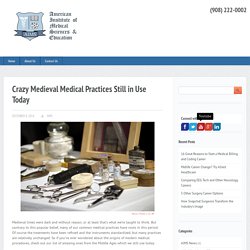

Crazy Medieval Medical Practices We Still Use. Medieval times were dark and without reason, or at least that’s what we’re taught to think.

But contrary to this popular belief, many of our common medical practices have roots in this period. Of course the treatments have been refined and the instruments standardized, but many practices are relatively unchanged. So if you’ve ever wondered about the origins of modern medical procedures, check out our list of amazing ones from the Middle Ages which we still use today: #1 Bloodletting A.K.A Phlebotomy We’re all shocked and disgusted when we hear about medieval bloodletting, but this seemingly crazy practice is still used today. . #2 Drilling Into Your Head? Ever have a headache so bad you’d be willing to have someone drill a hole in your head to make it stop? #3 Saving Sight, or Torture? Cataracts certainly aren’t a 21st century ailment, and neither is the treatment for them. . #4 I Wouldn’t Want to Be Awake… What’s dwale you ask?
Clyster also, known as the enema, was once considered a cure-all. 10 Bizarre Medieval Medical Practices. Creepy Medicine is one of the cornerstones of modern civilization—so much so that we take it for granted.

It wasn’t always the case that you could just waltz into a doctor’s office to have them cure what ailed you. In medieval times, for example, things were a lot more dangerous, and a lot stranger. 10 Boar Bile Enemas Enemas in medieval times were performed by devices called clysters. Even kings were high up on the clyster. 9 Urine Was Used As An Antiseptic Though it may not have been common, there is evidence to suggest that urine was occasionally used as an antiseptic in the Medieval Era. This isn’t quite as insane as it seems: urine is sterile when it leaves the body and may have been a healthier alternative than most water—which came with no such guarantee of cleanliness. 8 Eye Surgery (With A Needle) During the Middle Ages, cataract surgery was performed with a thick needle. Of course, eye surgery changed rapidly once Islamic medicine began to influence European practices. 4 Trepanning.
Health and Medicine in Medieval England. Health and medicine in Medieval England were very important aspects of life.

For many peasants in Medieval England, disease and poor health were part of their daily life and medicines were both basic and often useless. Towns and cities were filthy and knowledge of hygiene was non-existent. The Black Death was to kill two thirds of England’s population between 1348 and 1350. In 1349, Edward III complained to the Lord Mayor of London that the streets of the city were filthy: No one knew what caused diseases then. Other theories put forward for diseases included “humours”. Astronomers blamed the planets going out of line As important, no-one knew how diseases spread – the fact that people lived so close together in both villages and towns meant that contagious diseases could be rampant when they appeared; as happened with the Black Death.
13 Strange Superstitions: Bizarre Beliefs from Around the World. Tony Robinson on the top five superstitions that gripped medieval Britain. Ancient Britons didn’t despatch people willy-nilly, but in times of crisis – if a whole community was rocked by plague, say – then they might decide to sacrifice somebody as a way of bartering with the gods. In some cases, a wicker pyre in the shape of a man would be stuffed with animals and even human offerings. We can trace this practice back to Celtic times. The Celts saw the world in which they lived as crammed full of gods.
To appease them, they would sacrifice something important: tools, jewellery, a sword (which would be as valuable as a car in today’s terms), slaves or, ultimately, members of the community. This ritual only ended when new religions, like Mithraism and Christianity, took hold. Malleus Maleficarum, a handbook explaining how to identify, capture and kill a witch, was first published in Germany in 1487 and then circulated around Europe, stoking hysteria about witchcraft.
10 Completely Uncanny Superstitions From The Middle Ages. Weird Stuff In the pre-scientific Middle Ages, the world was at the same time both fascinating and frightening.

In the absence of proper knowledge, people had no choice but to fall back on their own imaginations to make sense of the myriad natural phenomena around them. The result was a world where everything seemed magical, a place teeming with angels and demons, fairies and goblins, elves, gnomes, and witches. This list takes us inside the medieval mind and the fears and superstitions through which it tried to explain the world. 10 The Sea In The Sky.